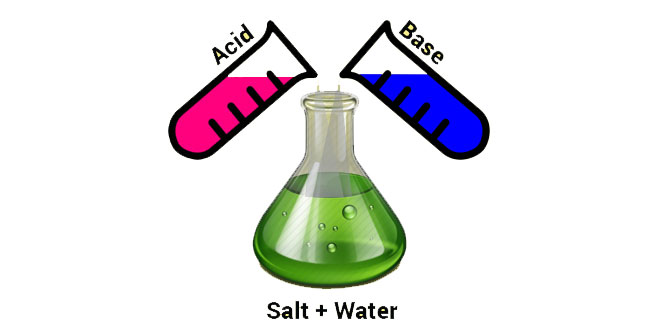Question: While eating food, you happen to spill some carry on you white shirt. You immediately scrub it with soap. What happens to its yellow colour on scrubbing with soap? why? What happens to this stain when the shirt is washed with plenty of water?
Answer:
- On scrubbing, its colour changes from yellow to reddish brown.
- It happens because soap is basic in nature and the colour of turmeric changes from yellow to reddish brown in basic medium.
- When the shirt is washed with plenty of water, the stain turns yellow again.
Question: Give reasons for the following:
(a) Dry HCl does not change the colour of dry litmus paper.
(b) Aqueous solution of an acid conducts electricity.
Answer:
- H+ ion from HCl cannot ionise to give H+ ions in absence of water. Acidic property like change in colour of litmus depends on production of H+ ion, hence there is no colour change.
- Acids, when dissolved in water, produce H+ ions. The electric current is carried through the solution by these ions.
Question: (1) What is the pH range for a base?
(2) How the strength of basic solution can be increased?
(3) Give an example of strong and weak base.
Answer:
- The pH range of a base is 7-14.
- The strength of bases depends on the number of OH– ions produced. So by adding OH– ions, the strength of basic solution can be increased.
- (i) Strong based: Sodium hydroxide solution.
(ii) Weak base: Magnesium hydroxide (Milk of magnesia).
Question: State the number of water molecules present in crystals of washing soda and Plaster of Paris. What are these water molecules called as?
Answer:
- Washing soda: 10 molecules of water.
Plaster of Paris: 1/2 molecule of water. - These molecules are called as water of crystallization.
Question: Effervescences are formed when the batter for cake is heated. Which substance is present in batter? Name the gas evolved. Write the chemical equation involved.
Answer:
(i) The substance present is baking soda (NaHO3).
(ii) Gas evolved is CO2.
Question: Acids do not acidic behavior in the absence of water but do so in water. Justify this statement with the help of a chemical equation.
Answer: Acids ionise in aqueous medium to form hydrogen ions. These hydrogen ions cannot exist alone, they exist after combining with water molecules. Thus aqueous hydrogen ions which are responsible for acidic behavior can exist in the presence of water only.
H+ + H2O → H3O+
Hydrogen ion Water Hydronium ion
These hydrogen ions are shown as H+ (aq) or hydrogenium ions (H3O+).
Question: What happens when:
(a) C2 is passed through lime water in limit?
(b) CO2 is passed through lime in excess?
Answer: (a) Lime water turns milky due to the formation of insoluble white precipitates of calcium carbonate.
Ca(OH)2(aq) + CO2(g) → CaCO3 (s)↓ + H2O (l)
Lime water [In limit] [White precipitate]
(b) The white precipitate of CaCO3 gets dissolved in excess of CO2 to form calcium hydrogen carbonate which is soluble in water.
Ca(OH)2(aq) + 2CO2(g) → Ca(HCO3)2 (aq)
Lime water [In excess] Calcium hydrogen carbonate [Soluble in water]
Question: What precaution must be taken diluting a concentrated acid?
Answer: Dilution should always be done by adding concentrated acid to water and not by adding water to concentrated acid. Since dilution process is an exothermic process, therefore, acid may spill out if water is added to a bottle containing concentrated acid.
Question: Crystals of copper sulphate are heated in a test tube for sometime.
(1). What is the colour of copper sulphate crystals:
(i) before heating, and (ii) after heating?
(2). What is the source of liquid droplets seen on the inner upper side of the test tube during the heating process?
Answer:
- (i) Blue (ii) White.
- Crystals of copper sulphate (CuSO4.5H2O) contain water of crystallization and on heating, these crystals loose water and become white. This lost water can be seen in the form of droplets on the inner upper side of the test tube.
Question: (i) Name the products formed when sodium hydrogen carbonate is heated.
(ii) Write the chemical equation for the reaction involved in the above.
Answer: (i) Sodium carbonate, water and carbon dioxide are formed.
Question: How is bleaching powder prepared? Why does bleaching powder:
(i) smell strongly of chlorine?
(ii) not dissolve completely in water?
Answer: Bleaching powder is prepared by the action of chlorine (Cl2) on dry slaked lime [Ca(OH)2]
Ca(OH)2 + Cl2 → CaOCl2 + H2O
Calcium Chlorine Calcium Water
hydroxide(dry) gas oxychloride
(i) It smells strongly of chlorine because CO2 present in air reacts with it liberating free chlorine.
(ii) It contains some unreacted lime which is insoluble in water. Due to this reason, some milkiness persists when bleaching powder is dissolved in water.
Question: A white powder A is a mild non-corrosive base and is used in the preparation of cakes. When the powder is heated, it gives another powder B. The powder B is recrystallised to get a substance C and which has detergent properties. Identify A,B and C and also write balanced chemical equations for the conversions of A to B.
Answer: A = Baking soda (NaHCO3),
B = Sodium carbonate (Na2CO3),
C = Washing soda (Na2CO3.10H2O)
2NaHCO3 → Na2CO3 + H2O + CO2
Question: (i) What is meant by the term hydrated salt?
(ii) Give two examples of hydrated salt which are white and state their chemical formula.
Answer: (i) Salt that contains water of crystallization.
(ii) Washing soda – Na2CO3.10H2O.
Gypsum CaHO4. 2H2O.
or Plaster of Paris – CaSO4. 1/2 H2O
 Class Notes NCERT Solutions for CBSE Students
Class Notes NCERT Solutions for CBSE Students





